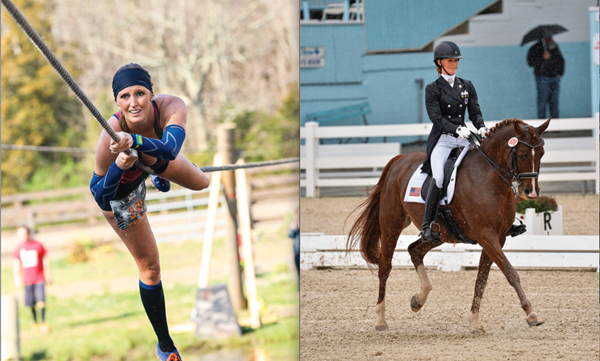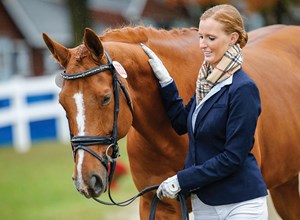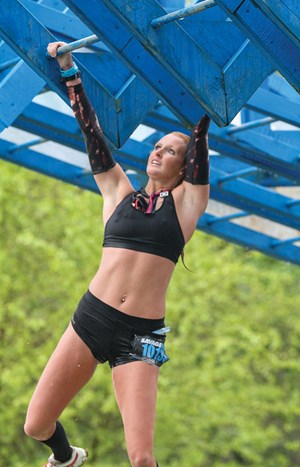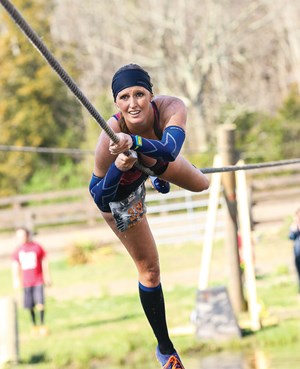
Patience, physical fitness, nutrition, preparation and perseverance—these are all things that I have learned as an obstacle-course racer (OCR) that allow me to succeed in the dressage world. It took me six years to make the North American Junior Young Rider (NAJYRC) team. For the first five years, it was the only goal I had and the only goal that I cared about achieving. When I didn’t do as well as I had hoped at a qualifier, it crushed me. Once I started OCR—foot races done by individual athletes—I realized there was more to life than riding and, not coincidentally, I started doing better at dressage shows. I made the NAJYRC team with a 67 percent test-score average. I finally had the clarity to focus without getting wrapped up in the absolute of winning or losing in competition.
Patience
Mistakes can happen, and I have learned that they are OK as long as we learn from them. There have been countless times that I have been pushed out of an OCR podium spot due to one small mistake that caused me to mess up on an obstacle. The worst thing to do is panic and try the obstacle again before you are ready. If you jump the gun and try to push harder and faster than you can, chances are you are probably going to fail. I have learned it is better to take my time, control my breathing and run my own race. If I get distracted by other racers, it will only cause my heart rate to rise while making me lose focus. This will likely result in a mistake in OCR or dressage.

In reality, we are going to make mistakes. The worst thing to do is skip the preparation and just rush into something. I have learned that if I don’t worry about the competition or the other horses and riders in the class, I will have a better ride. I have learned not to get caught up in the moment—I take a breath, make a correction and ride on to the next movement the way I run on to the next obstacle.
This philosophy helped me during my final USDF gold-medal ride. I was having such a great test until I forgot to count my two-tempis! I was so frustrated since they were so nice. However, I knew that if I were to pull off my final gold-medal score of 60 percent or higher in the Grand Prix test, I had to stay focused and prepare for the next movement. I had one of the best lines of one-tempis I have ever ridden in a test. The count was correct this time and I ended up getting the score I needed and winning the class. Not only did the mistake not ruin my test, but I used it to make sure I stayed focused for the next line of flying changes. I always try to remember: You can’t take back a mistake, but you can learn from it. I promise, I will never forget to count my tempi changes in a test again.

Physical Fitness
I have taken the idea of strengthening your weakness to heart when training in dressage and OCR. If I am weak at a certain OCR obstacle, I do exercises to help strengthen the muscles required to not only complete it once, but several times over. That doesn’t always mean repeating the obstacle to train it. (See “A Typical Training Week,” at right to learn more about my own fitness program out of the saddle.)
I apply the same thinking to dressage. For example, if a horse has an issue with the flying changes being clean and correct, it may be better to work on the quality of the canter. Once I am able to establish a clean three-beat canter with correct self-carriage, then I can work on the quickness of the horse’s hind legs. Often, if a horse can’t change clean, he can’t do a transition quick off the leg either. Instead of working the flying changes, I will work a lot of quality transitions (trot–canter, walk–canter, halt–trot) frequently to create an expectation for a better, quicker reaction each time. The goal is to get the horse responding to a light leg aid as soon as I ask. Once the strength is there, the original obstacle is usually easier to overcome. In this case, the flying change usually improves.
Nutrition
To participate in OCR or dressage, we have to be athletes. If we expect our horses to be athletes, we need to expect the same of ourselves. The more serious my racing has become, the more I have come to appreciate proper nutrition. I used to be the girl who would live off junk food. Now I meal-prep twice a week, making four days’ worth of food at a time. The difference in my performance has drastically increased since I have gotten my nutrition where it needs to be.
I routinely eat three meals a day and get a couple of snacks in between. A typical breakfast includes either a whole grain bagel or oatmeal with a power-packed smoothie containing blueberries, kale, chia seeds and peanut butter. Lunch is normally something like a peanut butter and jelly sandwich on whole grain bread and what is left of my smoothie. For dinner, I have a protein, like chicken or salmon, with a vegetable like broccoli or asparagus. I have a “magic” beet juice that I make myself and swear by to help me feel ready for the day. That isn’t to say that I don’t indulge in a doughnut after a competition!

Preparation
Not only has my nutrition improved, but also my general preparation for shows has become much better since I started OCR. When I get ready for a race weekend, what I do the weeks before is crucial to my success. It has made me better at knowing how to get my horse to peak at the shows as well. In both cases, I have learned that training hard in the days leading up to the competition will only lead to burnout and fatigue.
Ideally, in my OCR training, I start one month out and stop working on strengthening and focus more on maintaining strength. As I have found with OCR, this gives the body time to recover while still keeping the muscles moving and working. Two weeks out, I push a bit hard to get my body primed for the competition—be it dressage or OCR—and then I back off the week before to about 40 percent of the normal routine. This leaves me feeling my best. I want my best work of the show (or OCR) week to be when it counts, not in the days leading up to the competition.
After a horse show, there must be a few days of rest to allow the body to recover. I try not to compete more than twice in two weeks. That allows the body time to repeak properly with the minimum of two days off to recover before getting back into a program. If I have to show back to back weekends, I make sure that we rest for enough time after so muscles can fully recover.
Perseverance
In both dressage and OCR, the harder you work, the better you will become. I always think: No excuses! Since starting OCR, I have seen amazing things—people with no arms, legs, hearing or eyesight on course. Like dressage, people in their 80s are making it through successfully. It makes saying, “Well, I have a bad knee” or “I’m too tired” seem like just an excuse. Anyone who has the motivation to do it will do it. Both the OCR and dressage communities are so encouraging and helpful that no matter who you are, you can find a way. Both are sports for everyone—all ages, bodies and skill levels. Whether participating in OCR or dressage, with the right attitude and approach, anyone can succeed if he or she sets his or her mind to it.

Obstacle-Course Racing
One of the fastest-growing sports in the United States, obstacle-course racing (OCR) has had an estimated 4.5 million participants in the past year. The course can range from 1 to 25-plus miles on varying terrain with challenges that could include climbing walls, carrying heavy objects, crossing monkey bars and cargo nets and completing other tasks similar to what is seen on the popular show “American Ninja Warrior.” Races like Spartan and Tough Mudder made the sport popular when they were started in 2010 and have included a 98-mile course for the “World’s Toughest Mudder.” Since then, many companies now offer OCR and there is now an OCR World Championship—a competition that brought competitors to Oregonia, Ohio, from more than 22 countries last October.
A Typical Training Week
One of the biggest ways obstacle-course racing (OCR) has impacted my riding is by drastically improving my physical fitness. I used to think that riding multiple horses a day and doing barn chores were enough to keep me fit. I had no idea the strength I was lacking until I started OCR. I was suddenly required to have not only endurance and strength, but also upper-body endurance. Just as with riding, I needed a stable core and leg, but I needed much more control of my arms and shoulders. After I started training for races, my seat and position got much stronger and all of my horses started going better. I was able to have much more control over my body while applying my aids more effectively and in a much more timely fashion because of my increased muscle stamina.
Now that I am training for OCR, my schedule usually includes four runs—two of which are longer (10-plus miles) where I focus on keeping a moderate heart rate for one to two hours. One of the other runs is 30 minutes or more with a 25-pound weighted vest, carrying things like a 50-pound bag of horse feed or two 5-gallon gas containers full of water, weighing 80 pounds.
The other runs include speed/endurance-focused work, where the goal is maintaining a target heart-rate zone of 55 to 85 percent and not exceeding 95 percent of my max heart rate for at least 40 minutes. An example of that run might include two minutes of running 2 mph below my normal pace, followed by four minutes at my normal pace followed by one minute above my pace, then one minute even faster followed by one minute back below my pace. After doing this all for about 10 minutes, I go immediately into plyometric exercises that allow me to exert maximum force to increase my explosive power. This will help with my speed and full-body strengthening. They might include:
Lunge jumps with dumbbells. This exercise is great to work the legs and strengthen the all-important core.
Squats with barbells behind my neck (also called a back squat). A great full-body strengthening exercise that primarily trains the hips, thighs, glutes, quads and hamstrings. It also helps increase bone density and strengthen ligaments and tendons.
After 10 minutes of plyometrics, I repeat the running for 10 minutes and exercises again to total 40 minutes of work.
Magic Beet- Juice Recipe
Try Adriane Alvord’s “magic” beet juice that she swears by to help her feel ready for the day. You will need a juicer.
4 apples juiced
4 oranges juiced
4 lemons juiced
1 ginger root juiced
8 beets juiced.
Mix and then store in mason jars. The recipe makes enough for four servings.
Adriane Alvord is a USDF bronze, silver and gold medalist and has developed several horses to the FEI level. In 2015, Alvord was ranked 11th on the National Young Rider Ranking List and was sixth in the country for the USDF/Adequan Year End Rankings for Junior/Young Rider Grand Prix. In 2014, she began her fitness journey after her mother convinced her to do a Spartan Race with her. Since Alvord’s start in obstacle-course racing, she has earned eight podium finishes, six of which have been wins, and also earned a seventh place finish in her division at the 2015 Obstacle Course Racing World Championship. Alvord is now studying to earn her personal-training certification so she can help others with their own fitness journeys and runs Adriane Alvord Dressage, currently based out of Bolinvar in Middleburg, Virginia.











